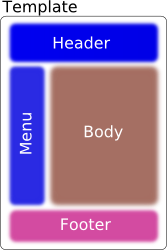Creating and using Tiles pages
After installing and learning some of Tiles concepts, it is time to create some pages. Here you will find the steps to create reusable Tiles pieces and complete pages.
Create a template
Let's take the classic layout page structure:

Create a JSP page that acts as this layout and place it under /layouts/classic.jsp file.
<%@ taglib uri="http://tiles.apache.org/tags-tiles" prefix="tiles" %>
<html>
<head>
<title><tiles:getAsString name="title"/></title>
</head>
<body>
<table>
<tr>
<td colspan="2">
<tiles:insertAttribute name="header" />
</td>
</tr>
<tr>
<td>
<tiles:insertAttribute name="menu" />
</td>
<td>
<tiles:insertAttribute name="body" />
</td>
</tr>
<tr>
<td colspan="2">
<tiles:insertAttribute name="footer" />
</td>
</tr>
</table>
</body>
</html>This template has five attributes: title (of string type), header, menu, body and footer.
Create the composing pages
In this phase, you have to create four JSP pages, that will take place of header, menu, body and footer attributes in the previously created template.
You can put everything you want in this pages, they are just a test.
Create a definition
By default, the definition file is /WEB-INF/tiles.xml. If you're using CompleteAutoloadTilesListener, tiles will use any file in the webapp that matches /WEB-INF/tiles*.xml or any file in the classpath that matches /META-INF/tiles*.xml; if several are found, it will merge them together.
But for now, let's stick to the default and create the /WEB-INF/tiles.xml file, with a definition as described in concepts:
<?xml version="1.0" encoding="ISO-8859-1" ?>
<!DOCTYPE tiles-definitions PUBLIC
"-//Apache Software Foundation//DTD Tiles Configuration 3.0//EN"
"http://tiles.apache.org/dtds/tiles-config_3_0.dtd">
<tiles-definitions>
<definition name="myapp.homepage" template="/layouts/classic.jsp">
<put-attribute name="title" value="Tiles tutorial homepage" />
<put-attribute name="header" value="/tiles/banner.jsp" />
<put-attribute name="menu" value="/tiles/common_menu.jsp" />
<put-attribute name="body" value="/tiles/home_body.jsp" />
<put-attribute name="footer" value="/tiles/credits.jsp" />
</definition>
</tiles-definitions>Render the definition
After creating the definition, you can render it:
- by using the <tiles:insertDefinition /> tag, inserting it in a JSP page:
<%@ taglib uri="http://tiles.apache.org/tags-tiles" prefix="tiles" %> <tiles:insertDefinition name="myapp.homepage" />
- in other cases, you can render directly in the response, by using the Tiles container:
TilesContainer container = TilesAccess.getContainer( request.getSession().getServletContext()); container.render("myapp.homepage", request, response); - by using Rendering Utilities provided by Tiles. For instance, if you've configured TilesDispatchServlet, you can render the definition above by requesting http://example.com/webapp/myapp.homepage.tiles.
- by using a supporting framework. See Integrations for a list of supporting frameworks.


